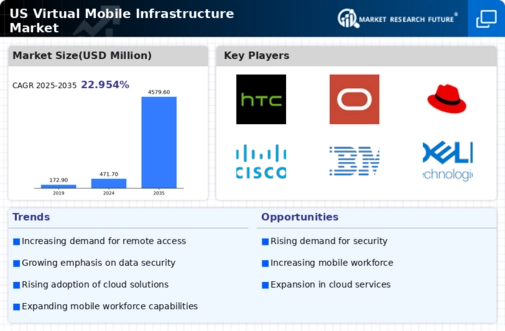The US Virtual Mobile Infrastructure Market is witnessing significant trends driven by the increasing demand for flexible work environments and enhanced security measures. The rise of remote work has catalyzed the integration of virtual mobile infrastructure solutions, allowing organizations to provide secure access to their applications and data from various locations. This has led to a growing emphasis on the adoption of mobile device management tools, which are crucial for managing and securing devices used in corporate environments.
The need for businesses to comply with stringent data protection regulations in the US, such as the GDPR and CCPA, is also propelling the trend towards virtual mobile infrastructure as companies seek solutions that ensure compliance while enhancing operational efficiency.
There are numerous opportunities for growth in this market, particularly in sectors that rely on mobile technology, such as healthcare and finance. With the increasing complexity of cyber threats, organizations are seeking sophisticated solutions to protect sensitive information. The healthcare industry, for example, can greatly benefit from virtual mobile infrastructures to protect patient data, streamline operations, and enhance telemedicine services. Additionally, the ongoing digital transformation across various industries presents an opportunity for service providers to offer tailored solutions that cater to the unique needs of different businesses in the US.
Recent times have seen a significant shift in consumer behavior towards mobile-friendly services, prompting enterprises to invest more in virtual mobile infrastructure capabilities. Companies are now focusing on enhancing user experience and optimizing application performance on mobile devices. As 5G technology becomes more prevalent, this trend is expected to accelerate, enabling faster and more reliable access to cloud-based services. Overall, the US market for virtual mobile infrastructure is evolving rapidly, driven by the dual demands of security and flexibility in today's mobile-first environment.






















Leave a Comment